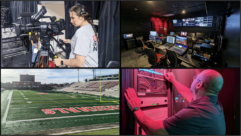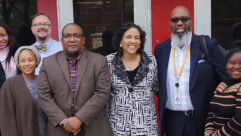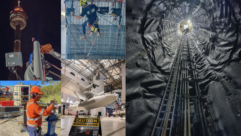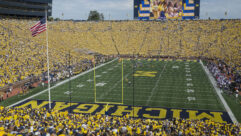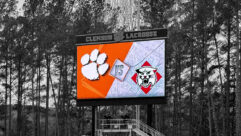
The Buzz: Installation Spotlight: Azusa Pacific University, Azusa, Calif.
Jan 1, 2008 12:00 PM,
By Trevor Boyer
Overflow Communications

To accommodate the more than 5,000 students for mandatory thrice-weekly chapel services, Azusa Pacific University in Azusa, Calif., holds services in two locations. To help the chapel production staff and students communicate with each other between locations, the school installed a Riedel Communications Artist system.
At the largest nondenominational Christian university in the United States, student attendance at thrice-weekly chapel services (with the exception of a handful per semester) is mandatory. The undergraduate population at Azusa Pacific University (APU) in Azusa, Calif., is more than 5,000, and the largest venue — Felix Event Center — on campus seats 4,000. What’s a growing school to do?
The answer for APU was co-location. Azusa Pacific holds services in both the Upper Turner Campus Center, which seats 1,200, and the newer, multipurpose Felix Event Center — and neither is considered the overflow location. With guest speakers, a full band, and sometimes pre-produced video and the school choir on the agenda for chapel services, two-way communication between the locations is crucial.
Usually there are music services in both locations, and video of the guest speaker is broadcast from one to the other. “There’s times where we do broadcast back and forth,” says Jeremy Lommori, production engineer at APU. “We’ve done split-screens with one person standing in one place and one person standing in the other, and they talk to each other.” To serve the demands of its technology-heavy worship services, APU employs a media services department as part of its staff.
This staff supervises groups of students, most of whom are majoring in cinema and broadcast arts, as they perform production crew duties for chapel services. For example, students run the front-of-house audio and operate the three Hitachi Z-3000 cameras in both the Felix and Upper Turner venues.
Each chapel venue has a dedicated TV control room and a student crew. “In both sites, there’s a director, a technical director operating the switcher, somebody running shading and graphics in the control room, and then three camera operators, as well as a front-of-house engineer, a studio engineer, and a lighting director,” Lommori says. There are also several stagehands and production staff within the two TV control rooms. All these people need to talk to each other — but not to everyone at once.
For that reason, Lommori recently installed a Riedel Communications Artist system for configurable digital audio (AES) communications over one of the school’s fiber-optic cables. The system includes two Artist 32 matrix frames and one Artist 64 frame, a control panel for each of these, plus several digital partyline (DPL) belt-packs. This enables both group and one-to-one conversations among producers in the control rooms, who use the rackmounted panels with configurable buttons to choose whom to talk to, and crew members, who wear the more limited 2-channel DPL belt-packs with XLR connections.
Each matrix frame is connected to several control panels via Cat-5 Ethernet cable. APU has three RCP-1028 rackmount panels, with 28 keys each, as well as several 16-button panels: six RCP-1016 rackmount panels, a DCP-1016 desktop panel, and a DCP1016e. “Each button has an eight-character LCD screen so you can type in CAMERA1, CAM2, CAM3,” Lommori says.
According to Lommori, the AES signals provide extremely clear audio with unnoticeable latency. They travel about two miles (along with data and the broadcast video and audio) over the course of the fiber-optic cable run from Felix Event Center to the Darling Control Room and on to the Upper Turner Campus Center and its control room.
Camera operators have their own communication channel via the Hitachi camera-control units. The Artist system digitizes these analog signals as it inputs them into the matrix.
As production engineer, Lommori makes sure the university’s AV systems work, managing the media infrastructure for the weekly chapel services, special large productions, and various AV-dependent events throughout the university. For instance, he makes sure the DVS 406 AD Extron scalers are properly feeding video as RGBHV to the Sanyo PLC-XF45 projectors in the Felix Event Center and the Epson XGA projectors in Upper Turner. He also manages the Riedel Artist system and continues to configure the matrix frames in order to maximize the system’s utility for the media services staff and student crew members.
“We’ve got [the Artist system] almost completely stable, and now we’re tweaking it and molding it for day-to-day operation,” Lommori says. “But for large events, we have to change our entire configuration.” Lommori says that he’s using the configuration utility that Riedel ships with the hardware to tweak the system offline before special events such as concerts by contemporary Christian music acts. “The ability to preplan that and then simply press a button and have it totally change all the panels instantly without rewiring, without unplugging a single thing, is a huge time-saver,” he says.
SUBSCRIBE TO SOUND & VIDEO CONTRACTOR E-NEWSLETTERS!
- Sound & Video Contractor Extra
Systems Integration Special Focus series:
- Houses of Worship
- Corporate AV
- Residential AV
- AV Over Fiber
- AV in Education
Breaking industry news in your email inbox every other week!
Subscribe atwww.svconline.com


